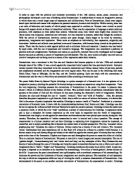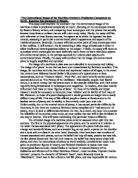Romanticism essay. Romanticism was a movement in the fine arts and literature that became popular in the late 1700s and continued through most of the 1800s. It was a revolt against the classicism belief system that was previously known.
In order to cope with the political and industrial movements of the 18th century, artists, poets, musicians and philosophers developed a new way of thinking called Romanticism. It enabled them to create an imaginative journey in which there was a much larger scope of expression and self-discovery. Prior to Romanticism, ideals were largely based upon intellect and reason with emphasis on personal restraint, decorum and discipline. Within society, there was a set code of behaviour and morals of which people were expected to conform to. Humans were viewed as social beings with respect shown to those in hierarchical authority. There was the expectation of language to attain technical precision, with emphasis on form rather than content. Urbanized areas were valued more highly than country life, where nature was measured, controlled and cultivated. Art was intended to instruct, rather than delight the audience. With the arrival of Romanticism, however, society saw great change. Ideals began to be ruled by emotions, spontaneity, imagination and inspiration. There came an emphasis on individuality, free expression, originality and innovation. Isolation and solitude were preferred over social interaction, with humans being viewed as the products of nature. There was the desire to rebel against politics and to eliminate limits and restraints. Literature was less bound by rigid codes, with the use of passionate and evocative language. The imagination was considered a pathway to spiritual truth and enlightenment. Pantheism saw nature as a powerful, untamed force to be worshipped and its rugged beauty was seen as sublime; a source of inspiration and exhilaration. The city, once valued so highly was now seen as a hub of corruption and art being used as a means of free expression rather than imitation.
Romanticism was a movement in the fine arts and literature that became popular in the late 1700s and continued through most of the 1800s. It was a revolt against the classicism belief system that was previously known. Romantic writers rejected what they considered to be the excessive rationalism and lifeless literary forms of previous periods and emphasized emotions and the imagination and over logical order. This can be seen in the following four texts; Kubla Khan, Frost at Midnight, On the Sea, and the Untitled painting. Each text deals with the conventions of Romanticism and the way in which they are presented differs according to techniques used.
The poem Kubla Khan by Samuel Taylor Coleridge is a prime example of a Romantic text. It is the epitome of an imaginative journey, showing the potential for human beings to recreate an experience using their imagination. From the very beginning, Coleridge presents the conventions of Romanticism in the poem. He states ‘a pleasure dome decree’, which is a biblical allusion to the Garden of Eden. This secluded notion of perfection immediately links the persona to the notion of God and the influence he has upon creating the character’s world of imagination. Biblical allusions are also used through the use of ‘sacred’, ‘miracle’, ‘holy’ and ‘milk of Paradise’. Here, the persona identifies that poetic inspiration is a gift from the Gods. Just as milk is a source of calcium for humans, it is shown that God is the source of poetic inspiration that enables Coleridge to create a world of ‘Paradise’. Pantheism is a common convention of Romantic texts. It deals with the interrelationships between God, Nature and Man. Coleridge uses this device to express the influences both God and Nature have upon his creative process. Coleridge invites the reader into a sensuous world, in which the river ‘Alph’ symbolises a stream of consciousness for Coleridge. It represents reality and is also a metaphor for human experience as the river leads to responder into the world of imagination. Romanticism was largely a revolt against the restrictions and boundaries that were placed upon society during the 18th century. Therefore, the repetition of ‘cabins measureless to man’ is ironical and is also a paradox. The concept of measurement is a human construct and yet here Coleridge is explaining how imagination cannot be measured, or controlled, and is simply something that is beyond our natural train of societal perspective. The line, ‘ancestral voices prophesying war!’ illustrates the nature of humans. Human nature has a history of war and violence. The ‘ancestral voices’ demonstrate how past experiences tell us that there will always be a threat to a perfect world because it is human nature to try and destroy things and relates to the rebellion against the natural grain of society that was evident prior to the time of the Romantics. Rhythm and rhyme are used throughout the poem to create the effect of a ballad. This is a common feature of Romanticism. The poem is also rich in visual imagery and sensory description. The use of ‘gardens bright’, ‘incense-bearing tree’ and ‘music loud and long’ are key examples of this. They illustrate the true beauty of nature through the eyes of Coleridge and help the reader to transform themselves into a whole new realm of imagination that is ‘fertile’, ‘bright’ and ‘blossoming’. Coleridge introduces the reader to an idyllic world. In part one, the poet is depicted as an architect as he describes his surroundings; ‘five miles of fertile ground’, forests ancient as the hills’. In part two, the poet is transformed into a philosopher, with a newfound awareness of his surroundings. He discusses the power and the limitations of human imagination and creative process. This transition of self represents the way in which our imagination shifts our way of viewing the world, a common characteristic of Romanticism. Also demonstrated in the poem is yet another common convention of Romanticism, the supernatural or exotic. Coleridge challenges the reader’s imagination by creating two worlds. Beneath the idyllic ‘Paradise’ that appears calm and ordered lies the realities that are beyond man’s control. This idea is further emphasising a previous point made about ‘ancestral voices’, in that we are introduced to the realities of human nature that are ultimately destructive and violent. Coleridge ponders with the idea of a world that is both ideal and sublime, but also mysterious and unpredictable. Thus, the poem is a celebration of the creative process. It appeals to both emotions and to the imagination as it captures the power and quality of a dream brought upon by the ability to facilitate creativity.







